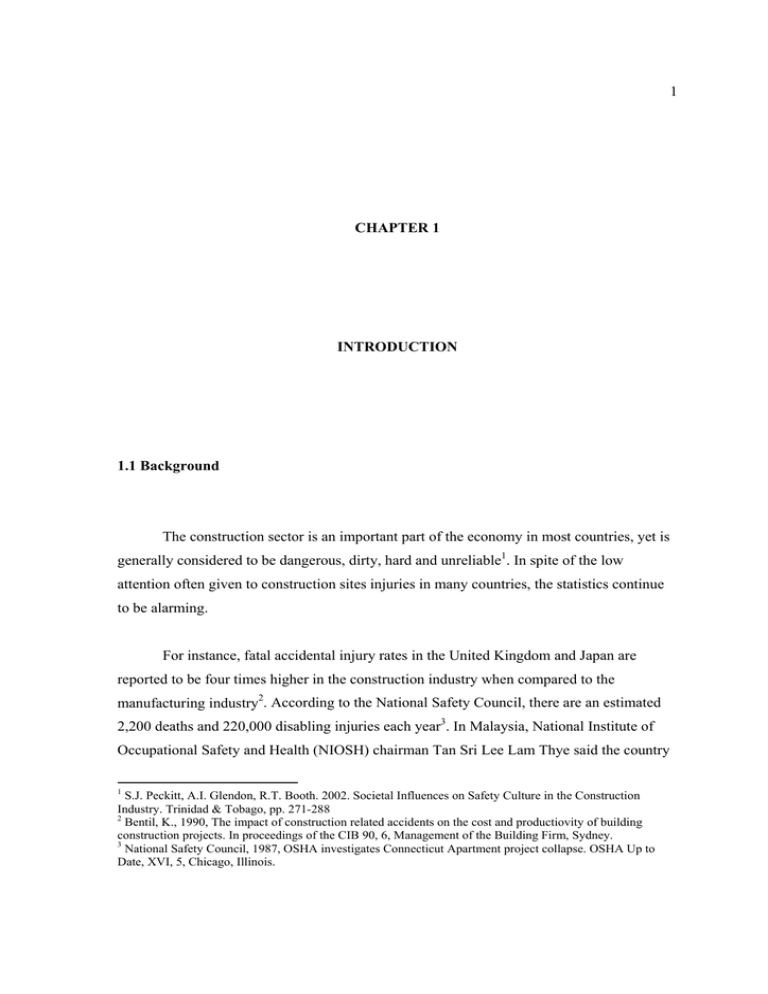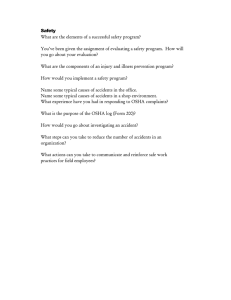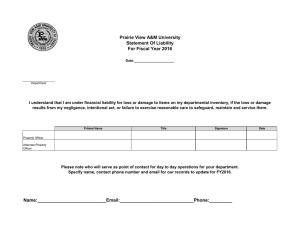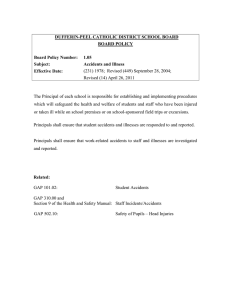1 The construction sector is an important part of the economy... generally considered to be dangerous, dirty, hard and unreliable
advertisement

1 CHAPTER 1 INTRODUCTION 1.1 Background The construction sector is an important part of the economy in most countries, yet is generally considered to be dangerous, dirty, hard and unreliable1. In spite of the low attention often given to construction sites injuries in many countries, the statistics continue to be alarming. For instance, fatal accidental injury rates in the United Kingdom and Japan are reported to be four times higher in the construction industry when compared to the manufacturing industry2. According to the National Safety Council, there are an estimated 2,200 deaths and 220,000 disabling injuries each year3. In Malaysia, National Institute of Occupational Safety and Health (NIOSH) chairman Tan Sri Lee Lam Thye said the country 1 S.J. Peckitt, A.I. Glendon, R.T. Booth. 2002. Societal Influences on Safety Culture in the Construction Industry. Trinidad & Tobago, pp. 271-288 2 Bentil, K., 1990, The impact of construction related accidents on the cost and productiovity of building construction projects. In proceedings of the CIB 90, 6, Management of the Building Firm, Sydney. 3 National Safety Council, 1987, OSHA investigates Connecticut Apartment project collapse. OSHA Up to Date, XVI, 5, Chicago, Illinois. 2 recorded 6.7 accidents per 1,000 workers in 2005 while the average in developed nations stood at only three to four accidents per 1,000 workers. Construction workers are two to three times more likely to die on the job than workers in other industries while the risk of serious injury is almost three times higher4. The industry has not been unresponsive to this state of affairs, recognizing that consistent excellence in worker safety requires a concerted effort on the part of everyone engaged in construction related activities5. The facts show that construction is indeed a dangerous industry. The tragic incidents showed that the construction industry only paid lip service to safety6. Department of Occupational Health and Safety (DOSH) director-general Abu Bakar Che Man said that at least 30% of construction sites have safety ratings of unsatisfactory or lower7. A construction site normally considered as a dangerous place. A large number of people die in them every year. Many site injuries result from people falling from structures like roofs and scaffolds, or being hit by falling objects. Many others are caused by the misuse of mechanical plant and site transport, including hoists8. There is nearly always keen competition for new contracts and site personnel are often under pressure to work to tight time and cost constraints. It is hardly surprising that safety is often neglected. The attitudes and behaviour of construction workers and managers towards safety is undoubtedly a major factor in the poor accident record of the industry. Construction workers accept that their work is demanding and risky, although they usually underestimate the risk. Group norms may cause individuals to ignore safety measures for fear of appearing cowardly to their workmates9. Many managers and workers resent outside pressures on them to comply with safety regulations and sometimes make collusive arrangements to avoid them. 4 Site Safe, 2000, The Facts about Construction Ijuries, October 23, http://www.sitesafe.org.nz/facts.html. Rowlinson. S. 2003. Construction Safety Management Systems. Spon Press. London. pp. 117 6 The Star Press. Many not Committed to Safety. 3 April 2005 7 Bernama Press. Workplace Accidents Must Be Reduced Further. 3 January 2006 8 Frayer, B., 1995, the Practise of Construction Management (London: Collins) 9 Laney, J.c.,1982, Site Safety, London and New York: Cosntruction Press. 5 3 Construction safety is always a grave concern of both practitioners and researchers. A number of causes influencing safety performance in the construction industry have been identified including worker’ attitudes10, safety policy, project coordination, economic pressure11, management training and safety culture. Due to the construction is considered as one of the most hazardous industries in the 12 world . The equal concern to those who are involved in construction is the matter of legal liability, should damage or destruction occur as a result of construction work. No one connected with the industry wants to see coworkers killed or injured on the job. Everyone working on the job must make a personal commitment to perform in a manner that does not endanger the lives and property of others. This is especially true for the various management groups involved in the construction project because they are responsible for managing the safety environment13. The construction professionals and the workers concerned with the construction process have both professional and legal duties to take care, not only of their own health and safety at work, but the health and safety of others who might be put at risk by their acts and omissions. Professional and legal duties should be compatible. As a general principle, the professional duty incorporates the legal duty. Construction parties therefore need to be aware of the existence and scope of the legal duties, and the standards of care required, to ensure that they, and their employers, discharge the duties and thereby avoid civil and criminal liability for breach of the duty. Construction parties need to keep up to date with relevant legislation and regulations and interpretations of legislation and regulations by the courts, and to be aware of the impact of changes. 10 Hinze, J., 1981, Human Aspects of Construction Safety. Journal of the Construction Division, ASCE, 107, pp. 61-72 11 Hinze, j., Raboud, P., 1988, Safety on large building construction projects. Journal of Construction Engineering and Management, ASCE, 114, pp. 286-293 12 Jannadi, O.A. and Bu-khamsin, M.S., 2002, Safety factors considered by industrial contractors in Saudi Arabia. Safety Science, 29, 1, pp. 15-24 13 Barber, J. 2002. Health and safety in construction, Thomas Telford Publishing. London. pp. 2 4 Construction parties should learn and share any lessons learnt from accidents that do occur. These additional concerns could be a source of conflict who health and safety law. Therefore the aim of this research is to identify the legal issues that relating to the liabilities of various party in construction sites regarding to the construction site safety. Measures taken to prevent occupational injuries and improve safety performance have been extensively explored14. However, there are not many researches about the liabilities of each construction player regarding to the construction safety. 1.2 Problem statement A safety culture was lacking in the industry though its players were aware of the laws and regulations under the Occupational Safety and Health Act15. Malaysia has very good laws on safety policies, but lack enforcement from the authorities16. There was also a need to intensify enforcement of the law pertaining to occupational safety and health and to take stern action against errant employers who flout the law. The divergent objectives of the major contracting parties, namely the client and constructor are within respect to the traditional project parameters of time, cost and quality. Safety is one of the first areas to be sacrificed in the effort to bring about equilibrium in these divergent objectives. A general trend in the courts to increasing frequency of lawsuits and increasingly large jury awards has also been causing problems for projects. The tentacles of liability have been reaching out to ensnarl parties with only loose connections to the administration of a 14 Laufer, A. and Ledbetter, W.B., 1986, Assessment of safety performance measures at construction sites. Journal of Construction Engineering and management, 112, 4, pp. 530-542 15 Sin Chew Jit Poh Press. Site Safety. 19 December 2005 16 Alfred A. Araya Jr. 2006. Workers discuss right to a safe working environment at IFBWW meet.http://www.cyberdyaryo.com/features/f2001_0329_03.htm 12 April 2006 5 project. Therefore it is important that managers of construction organizations stay abreast of trends in liability suits, including those that at present appear frivolous, and take steps to minimize liability expense on projects17. The contractor of the condominium-cum-office project at Plaza Damas along Jalan Sri Hartamas will be charged for non-compliance of the Occupational Safety and Health Act (OSHA) that resulted in the death of corporate figure Dr Liew Boon-Horng18. When accidents occurred at construction sites, contractors will be the one that general people will think he is the person to be liable. However, a contractor’s responsibility for safety on a construction job does not, however, reduce or remove from the designer and his agents and consultants any responsibility for the design of the work and for the safety of persons and property as it relates to the design of the work19. Responsibility for protection has become increasingly onerous in recent years, and it is possible that legal responsibility may extend to specification and use of hazardous materials20. All the parties involve in the construction process is responsible for the construction’s safety. All parties maybe liable to the construction accidents of the workers which will be depend on certain circumstances. The most recent significant ruling on design professionals' job site safety responsibilities comes from New Jersey, in Carvalho v. Toll Brothers. & Developers21. It is a United Cases but the decision from this case has cause the attention to the construction parties worldwide. The state's Supreme Court ruled that an engineer has a legal duty to exercise reasonable care for the safety of workers on a construction site when the engineer 17 Donald. S. 1984. Professional Construction Management. United States. pp. 374 The Star Press. Many not Committed to Safety. 3 April 2005 19 Abdul Aziz. 2002. Legal Obligation in relation to Labour Safety at Construction Sites. The Surveyor. Malaysia 20 Mohd. Majid. 2003.Insurance in Construction Contract. The Surveyor. Malaysia. 21 143 N.J. 56,675 A.2d 209 (1996) 18 6 has a contractual responsibility for the work's progress but not for the safety conditions, but becomes aware of site conditions that create a risk of injury. A site supervisor will be charged in the Sessions Court over the death of well-known corporate consultant Dr Liew Boon-Horng. The supervisor, who was arrested and released on bond yesterday, will also face a second or alternative charge of causing death by negligence. If found guilty on the first charge, he faces a jail term of up to 20 years; and on the second charge, up to two years22. It again showed that the other parties of the construction industry will be liable for the negligence purpose. The equal concern to those who are involved in construction is the matter of legal liability, should damage or destruction occur as a result of construction work. No one connected with the industry wants to see coworkers killed or injured on the job. Everyone working on the job must make a personal commitment to perform in a manner that does not endanger the lives and property of others23. 1.3 Research objective: 1. To determine the legal position of parties in construction contract with respect to their liabilities for safety of construction worker during construction. 22 23 The Star Press. Supervisor to be charged. 5 April 2006 Reid, J., 2001, High-risk industry baits kids, construction safety. Engineering News Record, Oct, 29, pp. 75 7 1.4 Scope of study: 1. Scope of construction site safety is limited to the liabilities of employers, main contractors, subcontractors, designers and workers. 2. Workers here referred to the general labour and labour for subcontractors only. 3. Court cases referred in study include Malaysia, Singapore, and English cases. 4. Court cases analysed are worker’s accident cases caused by human. The other safety issues such as incident caused by force majeure and diseases will not be discussed. 5. There is no limit to the cases chosen in terms of time frame, as long as it has never been overruled by higher court and still establishing a good law. 1.5 Significance of the study: This study will answer most of the uncertain issues that are arisen on the legal liabilities for the construction site safety of the workers. Various party involve in construction such as contractors, employers, designers, and workers himself would eager to know their liability according to construction site safety of the workers. It will become guidance for construction players when undergoing a construction project. With the legal basis provided by this study, he construction players will know what to do and what defense that they could apply if any accidents may be happen to their workers. This study aims to increase the awareness of the construction parties about the importance of the construction site safety which has become hot topic in current construction industry. 8 1.6 Previous research There are some previous researches that are studying about the topic regarding construction site safety. But the issues regarding liability of construction parties in the construction site safety have never been studied. The topics of previous researches are a below: 1. Effectiveness of site safety relation act a. Author: Mohd. Zakim Md., Tahir b. Year: 1997 c. Objective : Determine the effectiveness of the act related to construction safety 2. Safety at construction sites and construction’s workers’ rights in Malaysia a. Arthur: Soh heng Nin b. Year: 1977 c. Objective: Identify the actions to introducing safety during construction 3. Application of safety aspect in the building contract a. Arthur: Mohd. Nazri Bin. Zakaria b. Year: 2003 c. Objective: Study on safety aspect provided in construction building contract. 9 1.7 Research methodology: 1.7.1 Problems identification A wide area of topic will be studied. It is basically concentrated on the legal basis of the construction law because of the requirement of the master degree programme. It can be studied from the secondary source such as journals, previous research, articles, books and decided court cases. The problems occurred from certain issue arisen from certain topic will being analysed. Then, the research’s topic will be formulated. 1.7.2 Formation of objectives and scope of research After the literature review of the wide area of topic and formation of the topic, the objectives will be formed. This will be formed according to the problem statement that has been identified earlier. The scope of research will be stated to narrow the area of the research due to the time limit. It is important for the study to be concentrated to the relevant area. Then, the methodology of the study will be outlined and the tentative of the study will be identified as guideline for the whole study progress. 10 1.7.3 Data collection The relevant data for the literature review part will be collected from reference book, seminar papers, articles, journals and from the related website. It will be anaylsed in detail in order to achieve the objective of the study. Data for the analysis part will be collected from decided court cases from LexisNexis database and other resources of case law. The cases will be selected according to the critical issues that have been identified during the literature study. The cases will be sorted according to the critical issues. 1.7.4 Data analysis The data analysis process will be begun by conducting the study of cases on related legal decided court cases. Some issues of the phenomenon will be selected to be studied and then intensively investigating the characteristics of those issues. The judgment by the judge in each case will be stated clearly to differentiate each type of situation. Then, it will be followed by the learning about significant features of the issues and how it varies under different circumstances. After focusing on issues presented, discussion and comparison would be done. Finally, the consequences will be studied for each course of action, whether to the parties or to the society, and evaluate all points of view as well as developing the arguments that can be made further and against each of the various points of view. 11 1.7.5 Summary formation and report writing The summary of the study will be formed according to the analysis made before. The objective of research will be achieved based on the analysis. Some recommendation will be suggested for the future study. The finally, the final report will be formatted accordingly. 12 1.8 Flow chart of research methodology Identify a broad area of study Select the research topic Stage 1: Topic selection Literature review Problem identification Formation of objective and scope of research Stage 2: Research proposal Decision of research methodology Formation of data-gathering techniques Data collection Primary data • Decided court cases Stage 3: Data Gathering and processing Secondary data • Article • Journal • Research paper • Books • Website Data analysis Summary and suggestions Stage 4: Paper writing and summary Final report preparation




